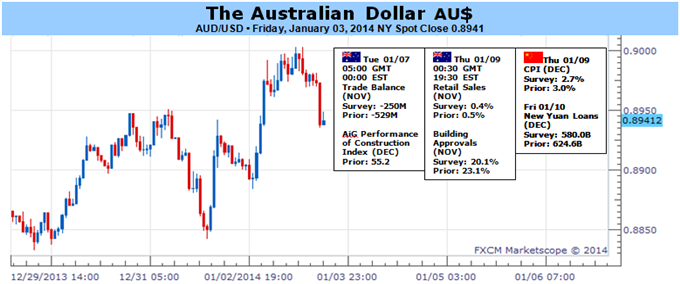
Fundamental Forecast for Australian Dollar: Bullish
Stable RBA Outlook, Supportive Chinese News-Flow to Help Aussie Recover
Firm US Data May Not Hurt Aussie as Markets Digest QE “Taper” Outlook
Help Pin-Point the Turning Point for the Australian Dollar with DailyFX SSI
We’ve argued that the Australian Dollar had room to correct higher as the calendar turned to 2014. We suggested that the fundamental argument for Aussie weakness had become flimsy while speculative traders remained heavily net-short. Absent new evidence to advance the case against the Australian unit, we said this opened the door for a period of profit-taking to drive the currency higher. A first step toward realization of our suspicions appears to have been taken, with AUD/USD starting the new year with its first weekly gain since mid-October.
Looking ahead, the domestic backdrop is little-changed. The priced-in RBA policy outlook remains stable, with data from Credit Suisse showing investors are betting on standstill over the coming 12 months. The week ahead offers relatively little in terms of significant home-grown event risk to undermine the situation. In any case, Australian economic news-flow has steadily improved relative to expectations over the past two months. That means the path of least resistance favors supportive results from next week’s Trade Balance, Retail Sales and Building Approvals releases.
On the external front, the first critical consideration is the fate of China, Australia’s largest trading partner and a leading engine of demand for the country’s key mining sector. Economists’ baseline 2014 GDP growth expectations were revised higher a month ago (according to a survey of analysts polled by Bloomberg). Data outcomes from the East Asian giant began to improve compared with median forecasts over the same period and short-term lending rates have reversed sharply lower, with the 7-day Shibor benchmark fixed at a two-week low of 4.711 percent on Friday. All told, this makes for a broadly benign landscape.
The second key factor on the external side of the equation is the US monetary policy outlook. The Aussie has been closely anchored to US treasury yields, falling in lock-step with a rise in borrowing costs as the Fed began to “taper” its QE effort and drove liquidation across assets that had benefitted from the stimulus program. Minutes from December’s FOMC meeting as well as last month’s NFP reading are in the spotlight in the days ahead. Both seem likely to support the case for further QE reduction: last month’s policy meeting saw Ben Bernanke and company resolve to begin scaling back asset purchases while US news-flow has been increasingly impressive since early November.
The extent to which this undermines the Aussie’s ability to recovery depends on the degree to which investors have already priced in the “tapering” cycle for the months ahead. Net speculative short positioning on US 10-year Treasury bond futures has been unwinding having hit a 19-month high last month, suggesting a period of digestion may already be underway. This means only an outsized positive surprise on the US data front that accelerates QE cutback bets stands to materially wound the Australian unit in the near term. – IS
DailyFX provides forex news and technical analysis on the trends that influence the global currency markets.Learn forex trading with a free practice account and trading charts from FXCM.
Source: Daily fx

